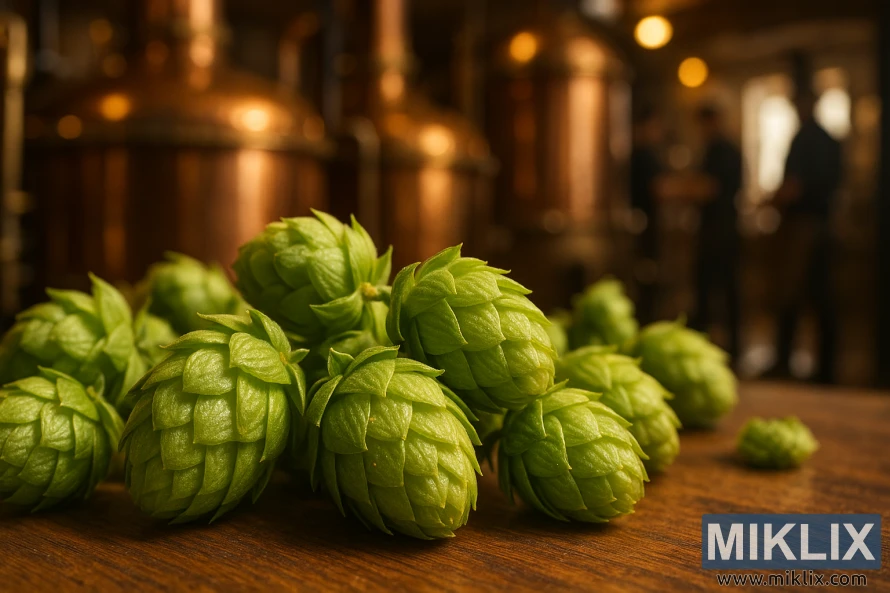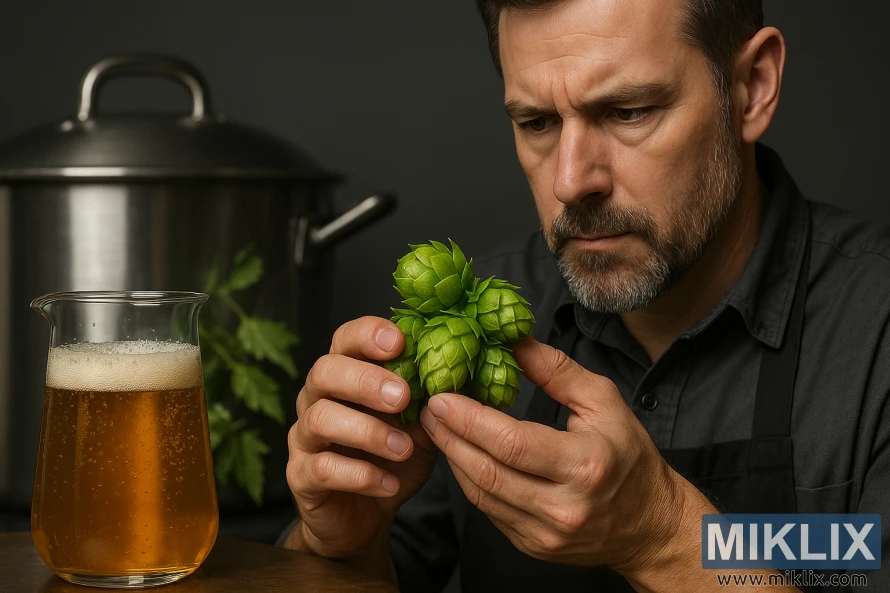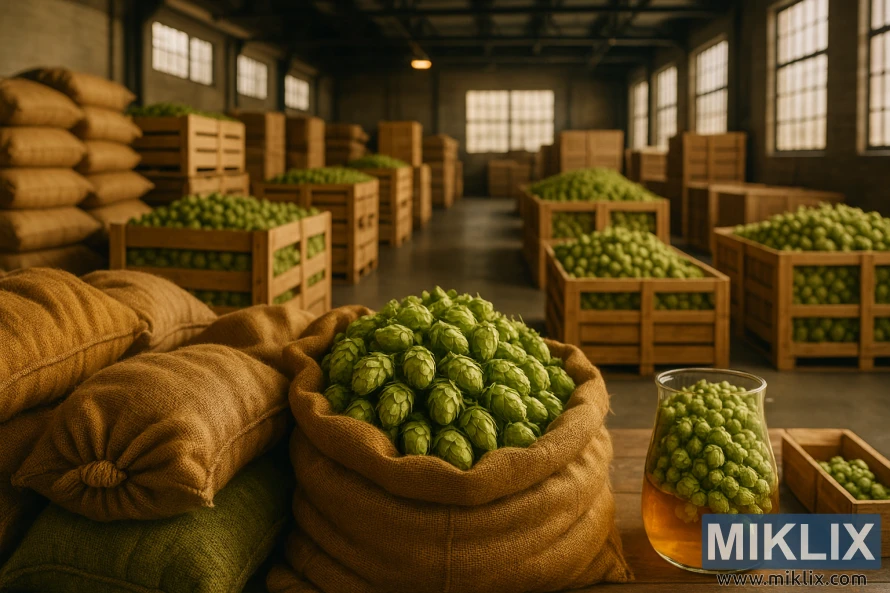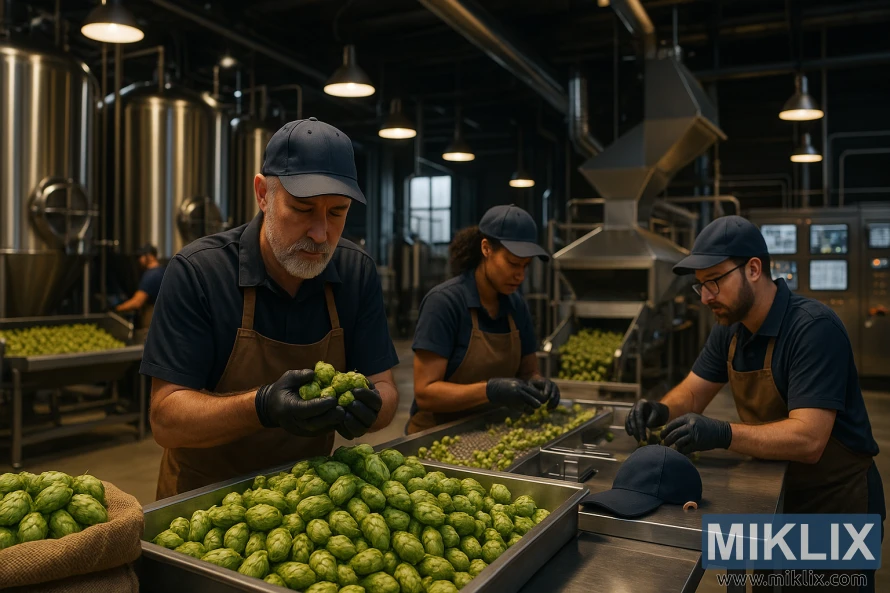Hops in Beer Brewing: Columbia
Published: July 25, 2025 at 7:51:32 AM UTC
Columbia hops stand out as a dual-purpose variety, fitting seamlessly into every stage of brewing. Their distinct flavor profile brings a burst of crisp pineapple and bright lemon-citrus notes to beers. This makes them a go-to choice for brewers aiming to craft unique beer styles. With their balanced brewing values, Columbia hops can elevate a broad spectrum of beer recipes. Their versatility ensures they can enhance a variety of beer styles, making them a valuable addition to any brewer's arsenal.

Key Takeaways
- Columbia hops are a dual-purpose hop variety.
- They offer a unique flavor profile with crisp pineapple and lemon-citrus notes.
- Columbia hops are versatile and can be used in various beer styles.
- They provide balanced brewing values for enhanced beer recipes.
- Columbia hops are suitable for all stages of the brewing process.
Understanding Columbia Hops: Origins and Development
The journey of Columbia hops began in the 1960s in Corvallis, Oregon. As a sibling to Willamette, they share a common ancestry. They were created for commercial brewing, aiming to meet the needs of the industry.
Initially, Columbia hops were destined for major breweries like Budweiser. Yet, they soon became accessible to a broader range of brewers. This openness contributed to their widespread use in different beer recipes.
The 1960s saw a major breakthrough in hop breeding with the development of Columbia hops. They are known for:
- High alpha acid content
- Distinct aroma profile
- Versatility in brewing applications
These traits have cemented Columbia hops as a favorite among brewers. Their unique characteristics enhance the flavor and aroma of beers. This makes them versatile for a variety of beer styles.
The history and development of Columbia hops highlight their significance in brewing. Their origins in Corvallis, Oregon, and their versatility in brewing applications underscore their value to brewers.
The Distinct Aroma Profile of Columbia Hops
The aroma profile of Columbia hops is a defining feature that contributes to their popularity among brewers. They are characterized by a unique blend of citrus and fruit notes. This makes them similar to Chinook hops but with a milder intensity.
One of the standout characteristics of Columbia hops is their ability to impart flavors of crisp pineapple and bright lemon-citrus to beer. This makes them an excellent choice for brewers looking to add a touch of citrus and fruitiness without overpowering the other flavors in their brews.
The distinct aroma profile of Columbia hops is a result of their complex chemical composition. This includes a balanced mix of alpha acids and essential oils. This balance is critical for achieving the desired flavor and aroma characteristics in finished beer.
By understanding the distinct aroma profile of Columbia hops, brewers can make informed decisions. They can decide when and how to use these hops to achieve the best results in their brewing endeavors.
Chemical Composition and Alpha Acid Content
For brewers, grasping the chemical makeup of Columbia hops is key to perfecting their craft. The alpha acid content, ranging from 5% to 9%, and beta acid content, between 3% and 4%, are critical. These acids blend to shape the beer's bitterness and flavor, defining Columbia hops' impact on the brew.
Columbia hops stand out due to their chemical makeup. Their alpha acids dictate bitterness, while beta acids influence flavor and aroma, albeit less so. This versatility makes them suitable for a variety of brewing needs.
Some key aspects of Columbia hops' chemical composition include:
- Alpha acid content: 5-9%
- Beta acid content: 3-4%
- Total oil content: Contributes to flavor and aroma
Brewers can use Columbia hops to craft a broad spectrum of beers. By understanding their alpha acid content and overall chemical makeup, brewers can adjust hop quantities and brewing methods. This ensures the beer meets their desired flavor and bitterness standards.
The balanced brewing values of Columbia hops make them a preferred choice for brewers aiming to create beers with nuanced flavors and balanced bitterness.
Flavor Characteristics in Finished Beer
Columbia hops are celebrated for their crisp, fruity taste in finished beer. This distinctive flavor comes from the hop's unique chemical makeup. Brewers use this to craft a variety of beers with a refreshing twist.
The flavor of Columbia hops is characterized by pineapple and citrus notes. These add complexity to the beer. They also complement various brewing ingredients, making Columbia hops a go-to for innovation.
In finished beer, Columbia hops' crispness boosts the brew's refreshment. Their fruity undertones enrich the flavor. This balance makes Columbia hops a top choice for many beer recipes.
- Crisp, fruity flavor profile
- Notes of pineapple and citrus
- Versatile for various beer styles
- Enhances refreshment and flavor complexity
Craft brewers can create a unique flavor profile by using Columbia hops. The hop's distinct taste makes it a key ingredient for memorable beers.
Best Beer Styles for Columbia Hops
Columbia hops are perfect for certain beer styles, known for their crisp flavor. Their unique traits make them a top pick for brewers aiming to craft refreshing, flavorful brews.
Columbia hops are versatile, fitting well into various beer styles. They are most commonly used in:
- Ales: These hops bring a crisp, refreshing taste to ales, ideal for brewers aiming for a light, easy-drinking beer.
- Pale Ales: The citrus and floral notes in Columbia hops complement the maltiness of pale ales, creating a balanced flavor.
- India Pale Ales (IPAs): Columbia hops add to the hoppy flavor and aroma of IPAs, making them a favorite among IPA brewers.
- Lager: Though often linked with ales, Columbia hops can also enhance lagers with a subtle hop flavor.
When brewing with Columbia hops, it's key to use techniques that highlight their best qualities. Techniques like late hopping and dry hopping can boost the flavor and aroma of the hops.
The chemical makeup of Columbia hops, including their alpha acid content, makes them suitable for a range of brewing techniques. By mastering how to use these hops, brewers can create a variety of beer styles that showcase their unique characteristics.
In summary, Columbia hops are a valuable ingredient in many beer styles, ideal for those seeking a crisp, refreshing flavor. By selecting the right brewing techniques and understanding Columbia hops' characteristics, brewers can craft beers that are both flavorful and refreshing.
Brewing Techniques with Columbia Hops
The art of brewing with Columbia hops requires a deep understanding of the best techniques for hop addition and dosage. These methods are key to unlocking the unique flavors and aromas of these hops.
To showcase Columbia hops in beers, brewers must explore various brewing techniques and hop addition methods. The timing and quantity of hop addition greatly influence the beer's flavor and aroma.
Several factors are important when considering brewing techniques. These include:
- The type of beer being brewed
- The desired flavor and aroma profile
- The optimal time for hop addition
By grasping these factors and adjusting brewing techniques, brewers can fully exploit Columbia hops. This might involve tweaking the hop dosage or trying different hop addition methods.
Effective brewing with Columbia hops demands a balance between the hop's natural traits and the brew's desired outcome. By mastering these techniques, brewers can craft a variety of beers that showcase Columbia hops' unique qualities.

Optimal Timing for Hop Additions
The timing for hop additions varies based on the beer style desired. Brewers must consider when to add hops to achieve the right flavor and aroma in their beer.
Hop additions can be made at different stages of brewing. Early additions, typically during the boil, add bitterness. Later additions, near the end of the boil or during fermentation, enhance flavor and aroma.
The timing of hop additions is key to the specific beer style. For instance:
- IPAs require late hop additions for a strong hop aroma.
- Traditional lagers get early hop additions for bitterness and subtle flavor.
- Sour beers often have minimal or no hop additions to highlight natural tartness.
Adjusting hop addition timing allows brewers to craft beers that match their style. Knowing the optimal timing is critical for creating complex, balanced beers that highlight Columbia hops' unique qualities.
Dry Hopping with Columbia Hops
Dry hopping with Columbia hops introduces a new dimension to beer's taste. This technique involves adding hops to the beer post-fermentation, often at the end of brewing or after packaging. It allows brewers to infuse the beer with hop aromas and flavors without the bitterness of boiled hops.
For brewers seeking intense, fruity flavors and aromas, Columbia hops are perfect. Their unique traits make them ideal for dry hopping. They can add citrus, stone fruit, and floral notes, elevating the beer's taste.
The advantages of dry hopping with Columbia hops include:
- Enhanced aroma: Columbia hops' aromatic properties are preserved and highlighted through dry hopping.
- Increased complexity: Adding dry-hopped Columbia hops adds layers to the beer's flavor, making it more complex and interesting.
- Flexibility: Dry hopping allows brewers to experiment with different hop varieties and quantities, opening up a world of possibilities for beer recipes.
To effectively dry hop with Columbia hops, brewers should consider a few key techniques:
- Quantity: The amount of hops to use can vary, but a common range is between 1-5 grams of hops per liter of beer, depending on the desired intensity of the hop flavor and aroma.
- Timing: Dry hopping can be done at various stages, from the end of fermentation to after packaging. The timing affects how the hop flavors and aromas integrate into the beer.
- Contact time: Allowing the hops to steep in the beer for an adequate amount of time is critical. This can range from a few days to several weeks.
By mastering the technique of dry hopping with Columbia hops, brewers can craft a wide range of beer styles. Whether aiming for a subtle hint of hop flavor or an intense, hop-forward beer, Columbia hops are a versatile tool in the brewer's arsenal.
Storage and Handling Requirements
To keep Columbia hops in top condition, following proper storage and handling is essential. These hops are prized for their unique aroma and flavor. Careful handling and storage can preserve these qualities.
For storage, keep the hops in a cool, dry place, away from sunlight and heat. The best storage conditions are a temperature between 32°F and 50°F (0°C and 10°C). Also, keep the humidity below 60%. This maintains the alpha acids and essential oils in the hops.
When handling Columbia hops, it's important to be gentle to avoid damage. Here are some best practices:
- Store hops in airtight containers or packaging to prevent air and moisture exposure.
- Ensure the storage area is clean and free from contaminants.
- Minimize handling to prevent physical damage to the hops.
- Use the hops on a first-in, first-out basis to avoid using older stocks before they degrade.
By following these storage and handling guidelines, brewers can keep their Columbia hops fresh and potent. This ensures the hops contribute the desired flavor and aroma to their beers.

Substituting Columbia Hops in Recipes
Brewers often face the challenge of substituting Columbia hops. This is necessary due to availability or specific flavor profile needs. Understanding how to substitute effectively is key.
Knowing the characteristics of different hop varieties is essential. Experts suggest using Centennial and Chinook hops as substitutes for Columbia hops. They share similarities in aroma and bittering profiles.
When substituting, consider the beer style and the role of hops in it. For instance, in a pale ale, Centennial hops can replace Columbia hops. This maintains a balanced bitterness and flavor.
- Consider the alpha acid content of the substitute hops.
- Adjust the quantity according to the desired bitterness and flavor.
- Be aware of the flavor and aroma profiles of the substitute hops.
By understanding these factors and making informed substitutions, brewers can create beers that showcase Columbia hops' unique flavor and aroma. Even when substitution is necessary, the result can be remarkable.
Common Brewing Challenges and Solutions
Understanding the characteristics of Columbia hops is key to solving common brewing problems. These hops are known for their distinct aroma. Yet, brewers may face issues that impact their beer's quality.
One major challenge is finding the right balance of flavor and aroma. To overcome this, brewers can tweak the timing of hop additions. This can significantly improve the beer's profile.
- Adjusting hop addition times to achieve the desired flavor and aroma profile.
- Monitoring the alpha acid content of Columbia hops to ensure consistency in bitterness.
- Experimenting with different beer styles to find the best match for Columbia hops.
By grasping the unique traits of Columbia hops and the challenges they pose, brewers can effectively troubleshoot. This allows them to craft high-quality beers that highlight the hops' distinct characteristics.
Commercial Brewing Applications
Commercial brewers are increasingly turning to Columbia hops to enhance the quality and character of their beers. These hops have become a staple in the brewing industry. They are ideal for ales and other beer styles that require a crisp, refreshing flavor.
The versatility of Columbia hops makes them an ideal choice for large-scale brewing operations. Their unique aroma profile, characterized by floral and citrus notes, adds depth and complexity to beers. Their high alpha acid content also contributes to a balanced bitterness, a key element in many beer styles.
In commercial brewing applications, Columbia hops are utilized in various ways to achieve the desired flavor and aroma profiles. Some of the key uses include:
- Bitterness adjustment: Columbia hops are used for their alpha acids to contribute to the bitterness of the beer.
- Flavor and aroma enhancement: Added during the brewing process, they impart their unique flavor and aroma characteristics.
- Dry hopping: Used in dry hopping processes to add a fresh, hoppy aroma to the finished beer.
The benefits of using Columbia hops in commercial brewing are multifaceted. They offer brewers the flexibility to create a wide range of beer styles, from pale ales to more complex, specialty beers. Their consistent quality and performance make them a reliable choice for large-scale brewing operations.
To maximize the use of Columbia hops, commercial brewers should consider factors such as optimal hop addition times, storage conditions, and handling practices. By understanding these elements, brewers can ensure that they get the most out of their Columbia hops. This results in high-quality beers that showcase the unique characteristics of these hops.
Pairing Columbia Hops with Other Varieties
The art of pairing Columbia hops with other varieties is key for brewers aiming to innovate and craft complex beers. By blending Columbia hops with complementary varieties, brewers can create unique flavor profiles. These enhance the overall character of their beers.
Columbia hops stand out for their balanced alpha acid content and distinctive aroma. They pair well with other hop varieties. For example, combining them with Cascade or Centennial hops adds citrus and floral notes. This maintains a balanced bitterness.
When pairing Columbia hops with others, brewers should think about the brewing techniques and beer styles. These will best showcase the combined hops' characteristics. Some popular techniques include:
- Using Columbia hops for bittering and another variety for flavor or aroma
- Blending Columbia hops with other varieties in the dry hopping process
- Experimenting with different hop addition times to achieve the desired flavor profile
The secret to successful hop pairing lies in understanding how different hop varieties interact. This includes their interaction with other beer ingredients. By experimenting with various combinations and techniques, brewers can discover new and exciting flavors.
Some recommended hop pairing combinations include:
- Columbia + Cascade for a balanced citrus and floral profile
- Columbia + Centennial for a bold, citrusy flavor
- Columbia + Willamette for a subtle, earthy character
Quality Assessment and Selection
For brewers aiming to craft exceptional beers, evaluating Columbia hops' quality is essential. The quality of these hops can fluctuate based on several elements. These include alpha acid content, beta acid content, and total oil content.
To guarantee the selection of premium Columbia hops, brewers must scrutinize these factors meticulously. Alpha acid content, for example, impacts the beer's bitterness. On the other hand, beta acid content and total oil content shape the flavor and aroma.
In choosing Columbia hops, brewers must align their selection with their beer's recipe needs. This entails understanding the ideal alpha acid content, the desired flavor profile, and the aroma characteristics.
- Evaluate alpha acid content for bitterness.
- Assess beta acid content for flavor stability.
- Check total oil content for aroma potency.
By meticulously assessing Columbia hops' quality and selecting those that fulfill their brewing objectives, brewers can produce beers that highlight these hops' unique traits.
Future Trends in Columbia Hop Usage
Columbia hops are leading the charge in brewing innovation. Brewers are exploring new techniques to fully harness their flavor and aroma. The evolution of Columbia hop usage is driven by emerging trends in brewing techniques and hop usage. These trends open up new avenues for brewers to highlight the unique qualities of Columbia hops.
One trend is the integration of Columbia hops into new beer styles. Brewers are venturing beyond traditional styles, incorporating Columbia hops into a wide range of beers. This trend is set to grow, with Columbia hops becoming a cornerstone in shaping the future of beer.
Another trend focuses on sustainability and quality. Brewers are increasingly seeking high-quality, sustainably grown hops like Columbia hops. By embracing these trends and techniques, brewers can create beers that fully showcase the capabilities of Columbia hops.

Conclusion
Columbia hops have emerged as a versatile and valuable addition to the brewing world. They bring a unique flavor and aroma that elevates the brewing experience. By grasping the characteristics and brewing values of Columbia hops, brewers can craft distinctive beers. These beers cater to a wide range of tastes and preferences.
The distinct aroma profile, flavor characteristics, and optimal brewing techniques of Columbia hops make them a standout choice. Brewers looking to innovate and differentiate their products find them attractive. As the brewing industry evolves, Columbia hops are likely to remain a favorite among craft brewers and enthusiasts.
Reflecting on Columbia hops, it's evident they offer unique attributes and brewing possibilities. They are a valuable component in the craft brewing world. They provide a rich and refreshing experience for beer enthusiasts.
Further Reading
If you enjoyed this post, you may also like these suggestions:
- Hops in Beer Brewing: Golden Star
- Hops in Beer Brewing: Super Pride
- Hops in Beer Brewing: Nelson Sauvin
